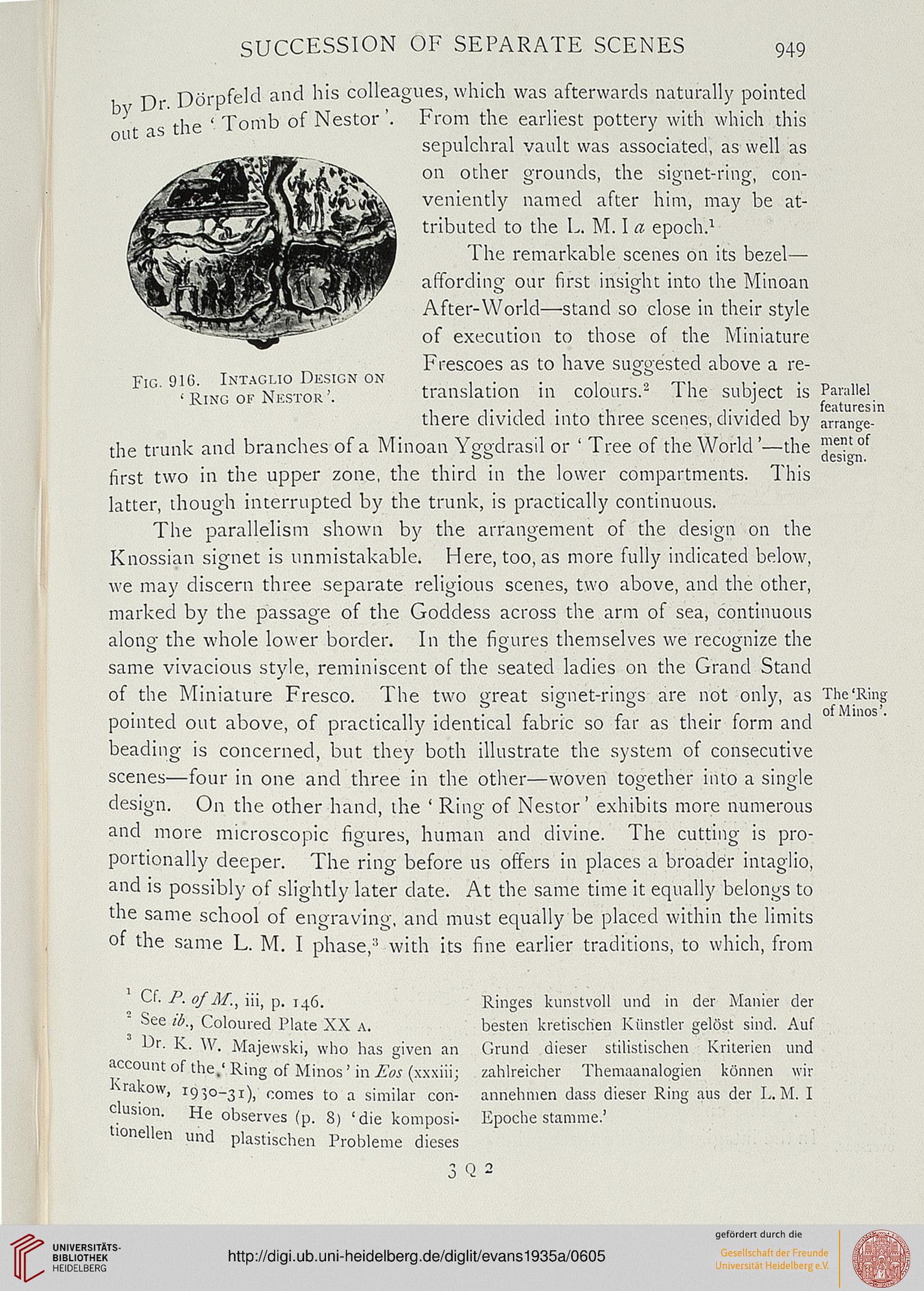SUCCESSION OF SEPARATE SCENES
949
out as
Fig. 916. Intaglio Design on
' Ring of Nestor '.
T) ■ Dorpfekl and his colleagues, which was afterwards naturally pointed
the ' Tomb of Nestor'. From the earliest pottery with which this
sepulchral vault was associated, as well as
on other grounds, the signet-ring, con-
veniently named after him, may be at-
tributed to the L. M. I a epoch.1
The remarkable scenes on its bezel—
affording our first insight into the Minoan
After-World—stand so close in their style
of execution to those of the Miniature
Frescoes as to have suggested above a re-
translation in colours.2 The subject is
there divided into three scenes, divided by
the trunk and branches of a Minoan Yggdrasil or ' Tree of the World'—the
first two in the upper zone, the third in the lower compartments. This
latter, though interrupted by the trunk, is practically continuous.
The parallelism shown by the arrangement of the design on the
Knossian signet is unmistakable. Here, too, as more fully indicated below,
we may discern three separate religious scenes, two above, and the other,
marked by the passage of the Goddess across the arm of sea, continuous
along the whole lower border. In the figures themselves we recognize the
same vivacious style, reminiscent of the seated ladies on the Grand Stand
of the Miniature Fresco. The two great signet-rings are not only, as
pointed out above, of practically identical fabric so far as their form and
beading is concerned, but they both illustrate the system of consecutive
scenes—four in one and three in the other—woven together into a single
design. On the other hand, the ' Ring of Nestor' exhibits more numerous
and more microscopic figures, human and divine. The cutting is pro-
portionally deeper. The ring before us offers in places a broader intaglio,
and is possibly of slightly later date. At the same time it equally belongs to
the same school of engraving, and must equally be placed within the limits
of the same L. M. I phase,3 with its fine earlier traditions, to which, from
Parallel
featuresin
arrange-
ment of
design.
The'King
of Minos'.
1 Cf. P. of M., iii, p. i46.
° See ii., Coloured Plate XX a.
Dr. K. W. Majewski, who has given an
account of the,' Ring of Minos' in Eos (xxxiii;
M-akow, 1930-31), comes to a similar con-
clusion. He observes (p. S) 'die komposi-
tionellen und plastischen Probleme dieses
Ringes kunstvoll und in der Manier der
besten kretisch'en Kiinstler geliist sind. Auf
Grund dieser stilistischen Kriterien und
zahlreicher Themaanalogien konnen wir
annehnien dass dieser Ring ails der L. M. I
Epoche stamme.'
949
out as
Fig. 916. Intaglio Design on
' Ring of Nestor '.
T) ■ Dorpfekl and his colleagues, which was afterwards naturally pointed
the ' Tomb of Nestor'. From the earliest pottery with which this
sepulchral vault was associated, as well as
on other grounds, the signet-ring, con-
veniently named after him, may be at-
tributed to the L. M. I a epoch.1
The remarkable scenes on its bezel—
affording our first insight into the Minoan
After-World—stand so close in their style
of execution to those of the Miniature
Frescoes as to have suggested above a re-
translation in colours.2 The subject is
there divided into three scenes, divided by
the trunk and branches of a Minoan Yggdrasil or ' Tree of the World'—the
first two in the upper zone, the third in the lower compartments. This
latter, though interrupted by the trunk, is practically continuous.
The parallelism shown by the arrangement of the design on the
Knossian signet is unmistakable. Here, too, as more fully indicated below,
we may discern three separate religious scenes, two above, and the other,
marked by the passage of the Goddess across the arm of sea, continuous
along the whole lower border. In the figures themselves we recognize the
same vivacious style, reminiscent of the seated ladies on the Grand Stand
of the Miniature Fresco. The two great signet-rings are not only, as
pointed out above, of practically identical fabric so far as their form and
beading is concerned, but they both illustrate the system of consecutive
scenes—four in one and three in the other—woven together into a single
design. On the other hand, the ' Ring of Nestor' exhibits more numerous
and more microscopic figures, human and divine. The cutting is pro-
portionally deeper. The ring before us offers in places a broader intaglio,
and is possibly of slightly later date. At the same time it equally belongs to
the same school of engraving, and must equally be placed within the limits
of the same L. M. I phase,3 with its fine earlier traditions, to which, from
Parallel
featuresin
arrange-
ment of
design.
The'King
of Minos'.
1 Cf. P. of M., iii, p. i46.
° See ii., Coloured Plate XX a.
Dr. K. W. Majewski, who has given an
account of the,' Ring of Minos' in Eos (xxxiii;
M-akow, 1930-31), comes to a similar con-
clusion. He observes (p. S) 'die komposi-
tionellen und plastischen Probleme dieses
Ringes kunstvoll und in der Manier der
besten kretisch'en Kiinstler geliist sind. Auf
Grund dieser stilistischen Kriterien und
zahlreicher Themaanalogien konnen wir
annehnien dass dieser Ring ails der L. M. I
Epoche stamme.'





